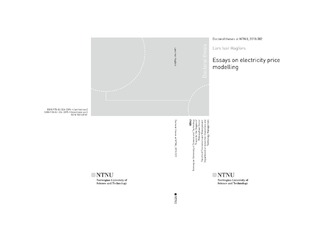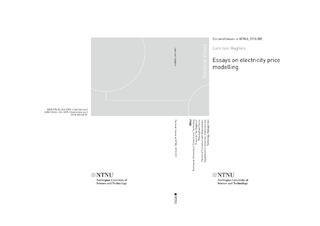| dc.contributor.advisor | Fleten, Stein-Erik | |
| dc.contributor.advisor | Westgaard, Sjur | |
| dc.contributor.advisor | Hagspiel, Verena | |
| dc.contributor.advisor | Linnerud, Kristin | |
| dc.contributor.author | Hagfors, Lars Ivar | |
| dc.date.accessioned | 2018-10-31T14:27:06Z | |
| dc.date.available | 2018-10-31T14:27:06Z | |
| dc.date.issued | 2018 | |
| dc.identifier.isbn | 978-82-326-3395-1 | |
| dc.identifier.issn | 1503-8181 | |
| dc.identifier.uri | http://hdl.handle.net/11250/2570444 | |
| dc.description.abstract | This doctoral thesis consists of 6 separate research essays. The essays all use various econometric modelling techniques to examine different aspects of the move towards cleaner energy in Europe, from an economic point of view. In doing this, this thesis makes contributions in two different fields. First, within the field of electricity price modelling. Every essay that is included in this thesis involves some form of electricity price modelling. Most notable is the use of quantile regression models. Here we develop a method where we look at the variations of the coefficients themselves across different quantiles and time periods in order to identify the main fundamental drivers behind extreme prices. Other modelling techniques are also applied, where appropriate. Second, within the field of real options, where we extend the literature by developing a real options model to choose between two different locations for a transmission asset, as well as a real options model to determine the economic value of investing in a large scale battery storage. These are applications in technologies that tie directly into the role of dampening the negative market effects caused by intermittent renewable energy.
In the first essay we develop a model using quantile regressions to examine the effect of various price drivers on the price distribution in the UK electricity market. Using this method, we are able to show how the sensitivity towards different fundamental factors change across quantiles and time of day. We also demonstrate how this framework can be used to perform a scenario analysis, by introducing shocks to one fundamental variable at a time, ceteris paribus, we can model how the price could be expected to react.
In the second essay we take the method we developed in the first paper and apply it to the German electricity market. We specifically focus the analysis on the renewable energy sources, wind power and photovoltaic, in order to learn how the market reacts to the introduction of the new renewable energy sources. We find some evidence that negative prices can be atrributed to the introduction of wind power.
In the third essay we look more closely at the positive and negative price spikes found in the German electricity market. We develop models to predict the probability of extreme price occurrences in the German day-ahead electricity market, primarily in order to determine the effect the different fundamental variables have on this probability. The main findings are that positive spikes are most closely related to high demand, low supply and high prices the previous day. Negative spikes, on the other hand, are related to low demand and high wind power production levels.
The fourth essay aims to model the EPEX and Nord Pool electricity markets using our quantile regression framework, in order to contrast and compare the effects of the various price drivers between the two markets. This is motivated by the plans to construct the NordLink cable, connecting the two markets. Our main findings indicates that the two markets behave very differently. This supports the hypothesis that connecting the two markets could both be economically viable and also be beneficial in order to reduce the spikes and volatility in the German market due to the differences in characteristics.
The fifth essay develops a real options model to evaluate two mutually exclusive transmission cable projects. The two alternatives being considered are a cable connecting Norway and the UK and a cable connecting Norway and Germany. This builds on the conclusions from essays 1-4, which together leads to a hypothesis that such a transmission cable is beneficial.
In the sixth essay we develop a real options model to evaluate the profitability of investing in a large scale battery bank. Having demonstrated the high volatility in the EPEX in previous essays, this technology would be one way of mitigating that problem while also potentially making a trading profit by buying low and selling high. While our numbers specifically relate to a particular battery technology, the same framework could also easily be applied to pump storage or similar Projects. | nb_NO |
| dc.language.iso | eng | nb_NO |
| dc.publisher | NTNU | nb_NO |
| dc.relation.ispartofseries | Doctoral theses at NTNU;2018:302 | |
| dc.relation.haspart | Paper 1: Hagfors, Lars Ivar; Bunn, Derek; Kristoffersen, Eline; Staver, Tiril Toftdahl; Westgaard, Sjur. Modeling the UK electricity price distributions using quantile regression. Energy 2016 ;Volum 102. s. 231-243
http://dx.doi.org/10.1016/j.energy.2016.02.025 | nb_NO |
| dc.relation.haspart | Paper 2: Hagfors, Lars Ivar; Paraschiv, Florentina; Molnar, Peter; Westgaard, Sjur. Using quantile regression to analyze the effect of renewables on EEX price formation. Renewable Energy and Environmental Sustainability 2016 ;Volum 32.(1)
This is an Open Access article distributed under the terms of the Creative Commons Attribution License (CC BY 4.0)
http://doi.org/10.1051/rees/2016036 | nb_NO |
| dc.relation.haspart | Paper 3: Hagfors, Lars Ivar; Kamperud, Hilde Hørthe; Paraschiv, Florentina; Prokozcuk, Marcel; Sator, Alma; Westgaard, Sjur. Prediction of extreme price occurrences in the German day-ahead electricity market. Quantitative finance 2016 ;Volum 16.(12) s. 1929-1948.
Is not included due to copyright available at
http://dx.doi.org/10.1080/14697688.2016.1211794 | nb_NO |
| dc.relation.haspart | Paper 4: A Comparative Analysis of Price Drivers of Day-Ahead Electricity Prices in EPEX and Nord Pool | nb_NO |
| dc.relation.haspart | Paper 5: Bakke, Ida; Fleten, Stein-Erik; Hagfors, Lars Ivar; Hagspiel, Verena; Norheim, Beate. Investment in mutually exclusive transmission projects under policy uncertainty. Journal of Commodity Markets 2016 ;Volum 3.(1) s. 54-69
http://dx.doi.org/10.1016/j.jcomm.2016.08.002 | nb_NO |
| dc.relation.haspart | Paper 6: Bakke, Ida; Fleten, Stein-Erik; Hagfors, Lars Ivar; Hagspiel, Verena; Norheim, Beate; Wogrin, Sonja. Investment in electric energy storage under uncertainty: a real options approach. Computational Management Science 2016 ;Volum 13.(3) s. 483-500
Is not included due to copyright available at
http://doi.org/10.1007/s10287-016-0256-3 | nb_NO |
| dc.title | Essays on electricity price modelling | nb_NO |
| dc.type | Doctoral thesis | nb_NO |
| dc.subject.nsi | VDP::Social science: 200::Economics: 210 | nb_NO |

